How To Decarb Weed
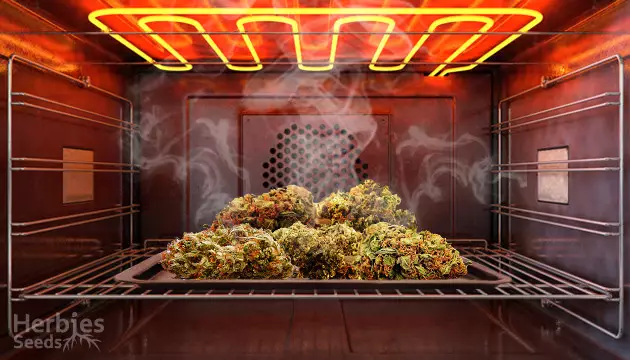
If you’ve ever been interested in making your own edibles, you may have run across the first step in your recipe as being to “decarb your weed.” But what exactly is decarbing and why is it necessary? Doesn't weed just get you high however you ingest it? While the answer is actually much more scientific, the process of decarbing is easy enough to follow, so you'll be properly informed and never have to purchase edibles ever again.
What Is Decarboxylation And Why Is It Important?
Ingesting raw cannabis will not produce any type of psychoactive effect on its own. So yes, that means everything that’s depicted in movies about eating a bag of weed and getting super baked is totally false. Decarboxylation is the process that must occur for the psychoactive components in your cannabis to become active and cause effects. Decarboxylation, the exposure of cannabis to heat over time, occurs instantaneously when cannabis is smoked and the weed reacts to high temperatures. However, if you want to make edibles, oils or tinctures, it’s necessary to decarboxylate weed before you try to use it for cooking, otherwise the THC will not adhere to fat solubles and will not be psychoactive.
We've Got Chemistry: Decarboxylation
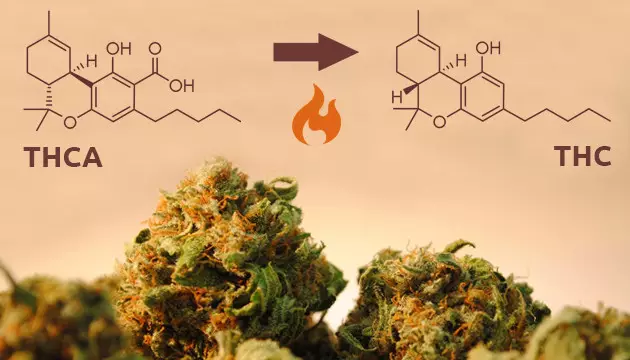
Cannabinoids located within the trichomes of raw cannabis flowers contain an extra ring of carboxyl (COOH), referred to as tetrahydrocannabinol acid, or THCA. THCA is a non-psychoactive component that can only be activated into THC once the raw cannabis has undergone decarboxylation. Exposing your cannabis to heat over a certain amount of time will cause the cannabinoids to break apart and convert THCA into THC. This is an almost instantaneous process when smoking, as smoking causes instant combustion (high heat/short amount of time), but knowing how to decarboxylate weed without doing so requires a different method of THCA combustion.
Turn Up The Heat: The Exact Temperature For Decarbing
The ideal temperature for decarbing begins at 250°F (121.1°C), and in order for it to work, your buds are going to need about 30 to 45 minutes of exposure. The full process of decarboxylation, depending on how much cannabis you’re decarboxylating at once, may take more time for the process to be fully complete. You can also decarb for longer periods of time at lower temperatures, starting from 217.5°F (102°C); this will help preserve the terpenes, which ensure the integrity of the special aromas and flavors in your cannabis. The integrity of your cannabis and decarbing process will be lost if temperatures exceed 300°F (148.9°C), causing bitter flavors and a more sedative, less psychoactive experience. So be patient, and just keep your temperatures on the lower end.
Do It Yourself: At-Home Decarbing
If you want to consume weed through other methods than smoking and still receive the psychoactive effects, it’s important to teach yourself how to decarb weed at home. There are various methods of decarbing your cannabis, all of which will produce the same desired outcome: heating your weed so it can be used in making your own edibles, tinctures or topicals.
In An Oven
The simplest way of decarbing weed at home would be to do it in an oven. It requires the fewest number of steps and the least amount of equipment; it’s also one of the faster methods of decarbing. However, it can cause major odors in your kitchen, so it may not be the best solution if you’re trying to be discreet.
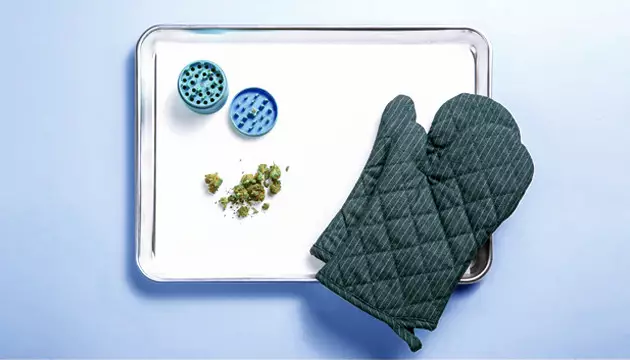
Equipment
To decarb your weed in the oven, you’re going to need:
- Baking tray
- Aluminum foil or parchment paper
- Cannabis

Directions
To effectively decarb your weed in the oven, ensure that you follow these steps correctly and mind the temperature of your oven; perhaps invest in an oven thermometer just to make sure.
- Set your oven to 225°F (about 107°C) and place your tray in the middle.
- Crumple up your aluminum foil or parchment paper into a ball and then flatten it out on the tray; this will help the cannabis from directly coming into contact with the bottom.
- Break up your cannabis into rice grain-sized pieces. Lay it lightly on the sheet and place another sheet on top. This is to avoid direct contact with the heat.
- Bake for 45 minutes.
- Remove your weed from the oven and let it cool for 30 minutes. You can use it immediately or store it for later use!
In A Mason Jar
Decarbing weed in a mason jar is one of the better methods of decarboxylation, as this helps to preserve the terpenes of your cannabis, which provide their own benefits and help to retain the taste and aroma of your cannabis.

Equipment
To decarb your weed in a mason jar, you’re going to need:
- Mason jar with lid
- Baking tray
- Kitchen towel
- Cannabis
- Oven gloves

Directions
Be careful when handling your mason jar and, again, make sure your oven is properly tempered.
- Set your oven between 220-240°F (104-115.5°C) and place the oven rack in the middle.
- Break up your cannabis into rice grain-sized pieces, put it in the mason jar, and lightly screw on the lid.
- Place a damp kitchen towel on the baking sheet and place the mason jar on the towel. This is to stabilize the jar as it sits in the oven.
- Place the tray in the oven and bake for 60 minutes. Periodically, take your mason jar out of the oven with your gloves and shake the jar lightly so as to evenly distribute the weed.
- After 60 minutes, remove the jar and let it sit for 30 minutes. The weed is good to use right away or can be stored for later.
By Sous-Vide
Decarbing by sous-vide is the most perfect way to decarb your weed at home. Through sous-vide, you’re able to reach the perfect temperature consistently and preserve the terpenes, and there’s virtually no smell to the process.
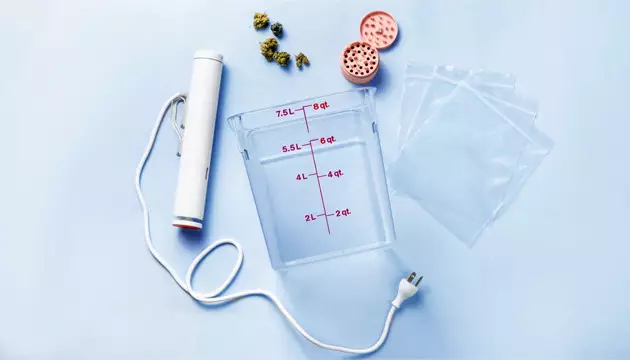
Equipment
To decarb your weed by sous-vide, you’re going to need:
- Immersion circulator
- Container for immersion circulator (plastic tub, large pot, etc.)
- Vacuum sealer or Ziploc-style freezer bags
- Cannabis
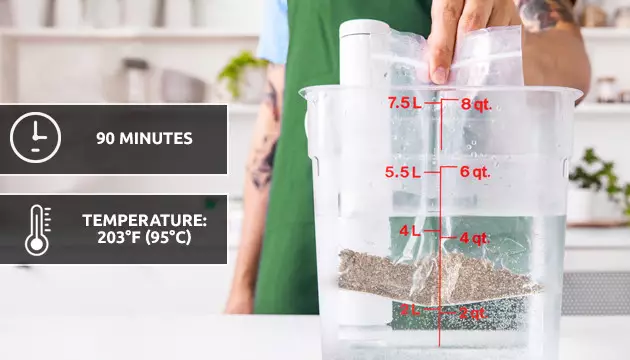
Directions
Using a sous-vide method is guaranteed to decarb your weed at a constant temperature, ensuring a near-equal distribution of decarboxylation throughout the entire batch.
- Fill your container with hot water and place your immersion circulator inside. Set the circulator to 203°F (95°C). (It’s important in this step to follow the specific instructions for your particular immersion circulator.)
- Grind your cannabis finely. Because the temperature will be regulated, there’s no need to worry about overheating your cannabis or destroying terpenes, flavor or THC.
- Use a vacuum sealer, or a water-displacement method if you’re using a plastic Ziploc bag, to tightly enclose your cannabis in the bag of your choice.
- Place the sealed bag into the water bath for 90 minutes.
- After 90 minutes, remove the bag and set aside to cool for 15-20 minutes. Your cannabis will be ready to use immediately or can be stored for later use.
Final Explanation Of Decarboxylation
Although the process of decarbing may seem intimidating at first glance, the process is actually very straightforward and can be easily achieved at home. Decarboxylation is arguably the most important step in the procedure of making weed edibles. It’s also a fascinating process that gives a deeper insight into the complexities of the marijuana plant and how much there still is to learn about its structures, functions and various components.
Herbies Head Shop expressly refuses to support the use, production, or supply of illegal substances. For more details read our Legal Disclaimer.


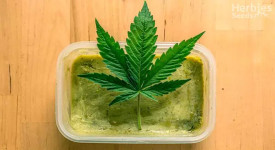

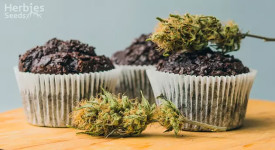
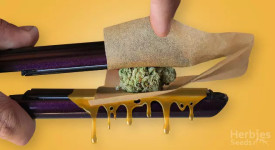
Thank you for leaving a comment for us!
Your feedback will be posted shortly after our moderator checks it.
Please note that we don’t publish reviews that: